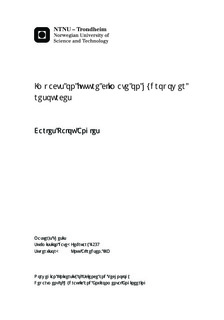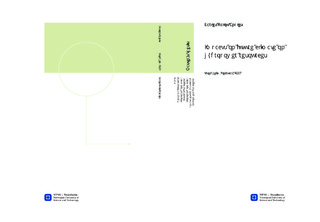| dc.description.abstract | 1 BACKGROUND
Studies based on older climate scenarios shows that the Norwegian hydropower system in general will receive more inflow but with a changed seasonal distribution. This will have implications on how the system is operated and also for the river environment due to changes in flow. This will most likely also lead to changes in mitigation practices and new mitigation measures might be needed in the future. Planning hydropower infrastructure is done for 40 or more years into the future, and an overview of possible changes in the future is therefore important.
In 2013, IPCC released the 5th assessment report (AR5) with a set of new climate scenario simulations from Global Circulation Models. These are based on a new way of describing the effect of future emissions, representative concentration pathways (RCPs). A considerable amount of work is done with the old 4th report setup, and there is a need to find out both how the system responds to the new scenarios and how past assessments correspond with the AR5 scenarios.
The purpose of this project is to downscale new climate data to the station level and see how these compares to the RCM predictions, to the past report scenarios and then to apply the downscaled data to two hydropower systems in Norway giving some regional variation in the data.
2 MAIN QUESTIONS FOR THE THESIS
1. Downscaling of climate data based on the CORDEX database.
a. Litterature review of current methodologies for downscaling to the station level. Further, review the CORDEX data and their direct application for delta change methods.
b. Select a method based on 1-b and downscale data for a select number of stations (to be determined later).
c. Prepare delta changed values based on the CORDEX data for comparison.
2. Assessment of downscaled precipitation and temperature values.
a. Compare the downscaled values for gauge sites within one RCM grid with the corresponding delta-changed values for the same grid cell based directly on the RCM (using Netra Timalsinas method).
b. Compare the downscaled station based data with the previous A1,B1,B2 scenarios from the Norwegian meteorological institute.
c. Select the data to use for task 3. Decide if current scenario simulation allows for direct use or if the delta change methods is also necessary for the station data.
3. In task 3 the data from 2) should be used in setting up a hydropower simulation. To make it possible to realize within the timeframe of the project we will not set up the hydropower models but use an already existing system.
a. Select the system to be used and provide an overview of the hydropower system based on the existing nMag model.
b. Based on the data from 2), compute the inflow to the selected systems for all downscaled scenarios
c. Run nMag with the current scenario and the future scenarios and evaluate changes in the results.
d. Provide a synthesis of changes in and between the two systems.
3 SUPERVISION, DATA AND INFORMATION INPUT
Professor Knut Alfredsen will be the main supervisor for the work. Dr. Roser Casas-Mulet will be working with the MSc candidate on developing the downscaling methods.
Discussion with and input from colleagues and other research or engineering staff at NTNU, SINTEF, power companies or consultants are recommended. Significant inputs from others shall, however, be referenced in a convenient manner.
The research and engineering work carried out by the candidate in connection with this thesis shall remain within an educational context. The candidate and the supervisors are therefore free to introduce assumptions and limitations, which may be considered unrealistic or inappropriate in a contract research or a professional engineering context.
4 REPORT FORMAT AND REFERENCE STATEMENT
The thesis report shall be formatted for the DAIM system. The report shall include a summary, a table of content, lists of figures and tables, a list of literature and other relevant references and a signed statement where the candidate states that the presented work is his own and that significant outside input is identified.
The report shall have a professional structure, assuming professional senior engineers (not in teaching or research) and decision makers as the main target group. | |

